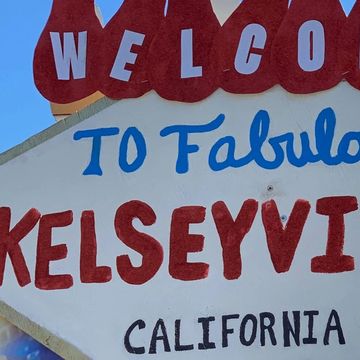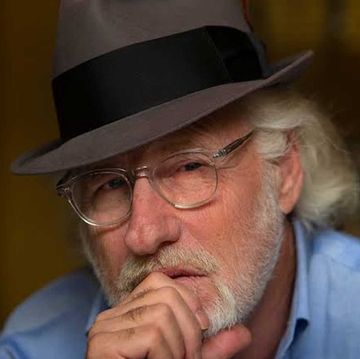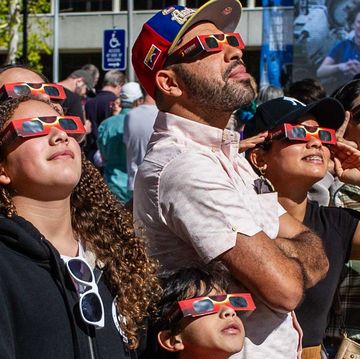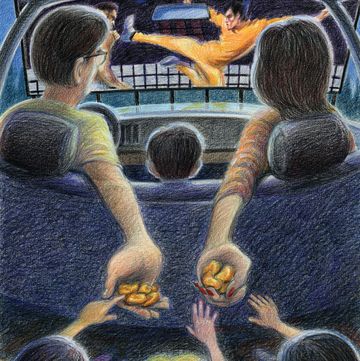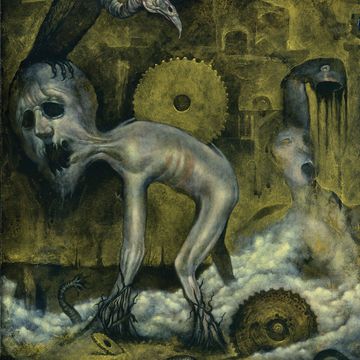For the past few months, I’ve been having a high old time playing with ChatGPT, and I’ve come away a true believer. The things it does well—explaining, translating, summarizing, organizing, generating ideas—it does astoundingly well. The things it has trouble with—telling the truth, understanding and generating humor—it nevertheless does well enough that one can easily imagine a day when it’s an all-purpose knowledge worker: a secretary, stenographer, research assistant, copy editor, planner, and, yes, a writer, that too.
It is flexible without end. I’ve asked it to write limericks, sum up books, explain concepts, query documents in detail (if you’re wondering, and you probably are, I haven’t used it here). I asked it to rewrite the lyrics to “Gimme Shelter” as if Herman Melville had written them, and it cheerfully complied: the result wasn’t impeccable, but it was convincing enough, and far better than I could do on my own.
Soon enough, I’ll be able to feed it everything I’ve written, from emails to novels; and it’ll adapt to my style. I’ll be able to say, “Write me a letter to my congressperson protesting his position on the homelessness crisis. Throw in some statistics but end on an optimistic note.” And it will do exactly that, instantly and in my voice. I’ll say, “Make it a little less self-righteous,” and it will do that as well. In a minute or two, I’ll have a very good draft, which I’ll massage into perfect shape and double-check, and then I’ll mail it off. What does this mean?
This article appears in Issue 25 of Alta Journal.
SUBSCRIBE
For our present purposes, there are two kinds of writing, distinguished both by their methods and by their intentions. Let’s call the first one everyday writing: the sort of thing a great many people engage in regularly. It includes most emails and diaries, social media and blog posts, memos and reports, college essays, and a preponderance of journalism. Its primary purpose is to convey information, and occasionally emotion, but even at its best, it doesn’t have much aesthetic value; nor is it meant to.
The second kind is writing as an art, which includes poetry and fiction, some essays, and a little nonfiction. It, too, can convey information and emotion, but it includes—in fact, it’s driven by—the desire to provide aesthetic pleasure of one sort or another.
These are significant differences, but they’re not absolute. Few distinctions are. There are plenty of marginal cases; we can discuss them another time. And while I could probably try to explain what I mean by “aesthetic pleasure,” that’s an argument for another time too. For now, let’s assume that we generally know it when we see it. I certainly know it when I’m trying to do it: writing as an art is simply a different activity from everyday writing.
So. We’re wondering whether AI will affect everyday writing, and the answer is yes, of course it will. Many, many people think more clearly than they write, and they don’t live in a world where notions of individual originality are assigned extraordinary value. Reading is indispensable, but for most people, writing is a chore, and for them, AI will be as useful as Hallmark greeting cards—in fact, much more so, since it can be tailored to be personal.
Is this bad? There are those who say that one can’t learn to read without learning to write, which is why the two are usually taught simultaneously. And it’s true that basic literacy will always be important. But we should remember that calculators haven’t prevented people from learning basic numeracy: arithmetic and the like. The same will be true of prose, at least in its most utilitarian form.
Let me make another distinction, between a tool and an instrument. A tool is something that helps you get where you want to go; an instrument is something that tells you where you can go. A tool is a means to an end. An instrument is more like a collaborator. (Every instrument is a tool, but not every tool is an instrument.) The photographer tells the camera what he wants it to do. The camera tells the photographer what it’s capable of. Together, they work it out. And the same thing happens with musical instruments, different kinds of paints and brushes, building materials for architects, the human body in dance.
But writing, alone among the arts, has no instrument, only the language itself, its rhymes and assonances, its logic and its rhetoric. As a result, writers have no downtime, no busywork: there’s nothing equivalent to changing your strings or stretching your calf muscles or cleaning your brushes. There’s no rehearsing, no tryouts or test runs, no exercises designed to keep your chops up. Language is an abstract thing that comes to life only when you push on it, and as soon as you push on it, you’re writing.
That said, there are tools, at least for some of us. Stephen Sondheim used a rhyming dictionary; James Merrill used a Ouija board; John Cage, the I Ching. Kathy Acker sliced up other people’s books. The OuLiPo gang used random linguistic constraints. Of these, I find the last two almost unreadable, and also keenly admirable. I’m not here to spare you paradoxes.
At the very least, AI will be a fantastic tool. Consider the following tasks: Give me 10 names that hippie parents might choose for their daughter. Give me 10 fictional, fashion-house names for a lipstick that’s a sort of red-orange color. Show me a chapter-by-chapter graph of the narrator’s happiness or unhappiness. Take sections 8 to 14 and put them in strict chronological order. Now in order of the ages of their protagonists. Now in random order. Remove 500 words from chapter 3 without changing the information it contains. Give me five reasons why a troubled married couple might divorce and five reasons why they might decide to stay together instead.
Is this cheating? No more so than consulting The Great Big Book of Hippie Names. It’s just much faster and more flexible. Speed and ease aren’t always virtues: Susan Sontag once warned me of the dangers of using a word processor; she said that it tends to make us both glib and long-winded. But gratuitous obstacles serve no one. A similar argument could be made against using a typewriter rather than writing longhand and against writing longhand rather than chiseling your words into a piece of marble. As I write, the Writers Guild of America is striking, in part out of fear of being replaced by AI; journalists are worried, professors are angry. These are real issues, but they’re economic, not metaphysical. The world moves forward and never backward. History doesn’t care. People thought Kraftwerk was the end of an art form too.
For now, AI is a tool, but it’ll soon be an instrument. We ask it questions, we select from it what we want, we ask it more questions. We assign it roles: Speak to me as if you were a 70-year-old woman trying to extend her life indefinitely, as if you were a high school English teacher, as if you were a wildcatter in West Texas. Note that in each case, it’s the writer who provides the context, sets the terms, and decides what to use: nightmare scenarios of AIs operating on their own from beginning to end strike me as unlikely, if only because humanity will always be their master, a power we derive not from being smarter or even more soulful but from being the audience.
The phenomenon of art is, in essence, an exchange. An experience that can’t be had otherwise is traded for something else: money, often enough, but also attention, admiration, an investment of time and a specific kind of mental effort. If you think of these things in economic terms, the poles are production and consumption. If you don’t, they’re creation and appreciation. In the Western world, since, say, Shakespeare’s day, we have come to think of that exchange as special, a form of communication between two minds. But of course, many great artworks have no specific authors. Medieval cathedrals are the classic example; much of the Old Testament is another; Homer’s works, another (there’s an old joke about a PhD candidate in classics who is working on a dissertation claiming that it wasn’t Homer who wrote The Odyssey but another blind Greek with the same name). And now we have movies, which, despite the popularity of the auteur theory, are also mass efforts, involving directors, actors, cinematographers, effects technicians, editors, set decorators, and dozens more, all of whom prevent the actual film from having anything like a traditional author.
It’s easy to forget this, but step into a medieval cathedral and it all comes back. One’s awe isn’t diminished; if anything, it’s increased. Writing may end up like that—like it once was—mysterious in its origins, but no less powerful in its effect. Eventually, an individual typing out something in disconnected solitude will come to seem quaint, modest, charmingly imperfect—a kind of artisanal undertaking, if you will. People still play chess, even though a computer can beat them all. Some will continue to write alone for the same reason. I might myself, and there’d be some glory in it, but not as much as there once was.
In Victor Hugo’s The Hunchback of Notre Dame, there comes a moment when an archdeacon named Claude Frollo glances from Notre-Dame itself to a printed book—then a new technology. He turns back to the cathedral, then once more to the volume. “Alas,” he sighs. “This will kill that.” Two paragraphs later, he explains what he means: “The Nile rat kills the crocodile, the swordfish kills the whale, the book will kill the edifice.” The novel is set a couple of decades after the invention of movable type, and the archdeacon’s point is that the printed book’s arrival means the death of the cathedral, at least in its original function, as the host of learning, community memory, storytelling, and so on.
AI will kill the book, at least as we understand it. Oh, the physical object will hang around: it’s a remarkably efficient and useful bit of technology. But no longer will it be a thing created by an individual—not entirely, anyway. The change will be slow and tentative, and then very fast and ruthless, and all along a little bewildering. How will we react? I can only speak for myself.
Suppose, someday, I read a novel and love it, truly love it, for its style and profundity and daring. Suppose I then find out that it was written with considerable help from a machine, which was given an elaborate set of prompts. How will I feel? Disappointed, no doubt, and possibly defrauded. But I will learn something from the experience, and the next time it happens, I won’t feel quite as off guard. And soon it will come to seem perfectly normal.
This is how things work: a technology comes along that seems, at first, like cheating, like an attack on the very principles that define the medium. Photoshop is a good example of this. So are MIDI and Auto-Tune, Pro Tools, AVID, CAD/CAM, and so on. The fear is that these things remove the human, creative element and replace it with a system that ingests the work, transforms it, and then spits it back out in a marginally different way. But let’s not pretend that many, many people don’t work the same way, as a cursory search for movies about cops or vigilantes, one-last-heist dramas, whodunits, and romance novels will quickly reveal. And as these kinds of technologies get more sophisticated, and artists get more used to them, truly new things can arise. Some of our greatest photographers now use Photoshop freely: Jeff Wall is an example. Andreas Gursky is another.
I have always believed this: Sufficient unto the day is the art thereof. We get the art we need, we get the art we deserve, and if tomorrow our needs and deserts change, our art will change as well. And this I believe, too: Aesthetic experience is sacred, but the production of it isn’t. If the stuff is good, it doesn’t matter how it’s made. In time, we’ll learn that, and the time has already started.•





